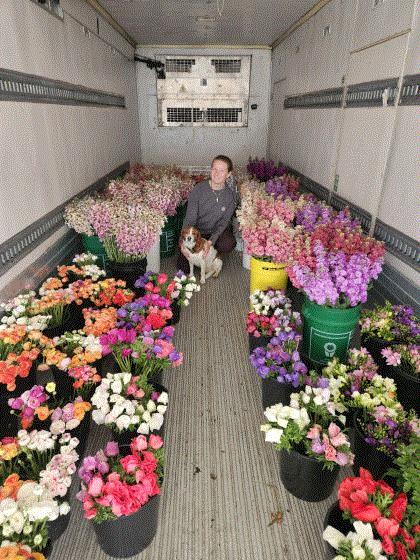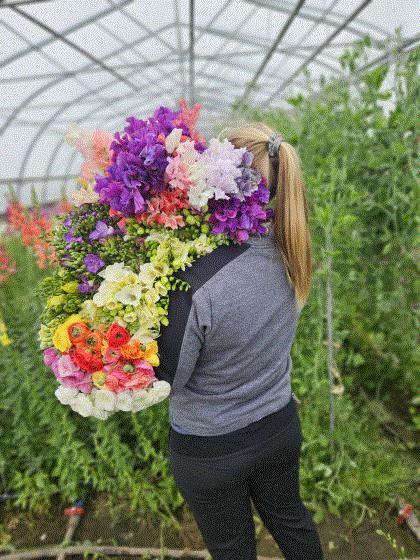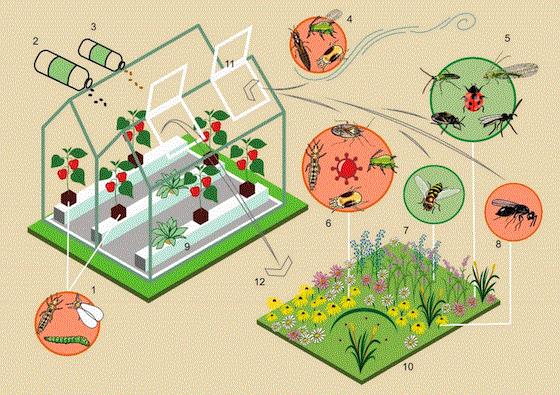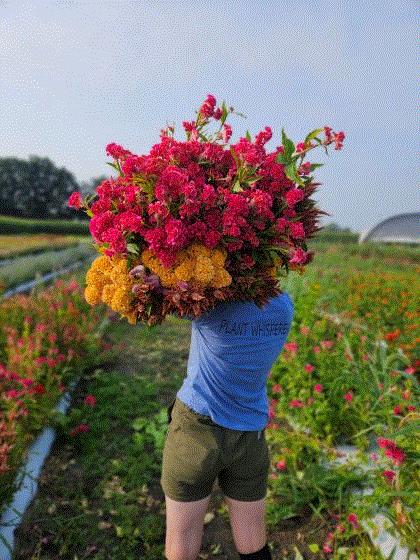Mother's Day 2024 Recap

Tater and I rented a 34-ft. semi trailer for our flowers this season. Our 24-ft. cooler was full to the brim, as well.
Mother’s Day was one for the record books! Tater and the Forget Me Not crew cut more than 17,000 stems and serviced 29 florists in southeast Michigan and northwest Ohio this Mother’s Day. Yet even with our record harvest, the demand for Michigan-grown flowers at Mother’s Day exceeded the supply. Which is a great problem that presents its own set of challenges! (More on this later.)
After three years of fine-tuning and careful planning, we had a healthy offering of the following flowers: anemone, ranunculus, poppy, pansy, stock and snapdragon. The sweet pea, delphinium, foxglove, dusty miller and scented geranium were supporting cast members in our Morther’s Day lineup this year. Every precious stem was sold!
Tater and I started taking preorders at the end of March through the third week of April. I always get apprehensive promising inventory so far in advance, but it is a must since florists create their floral recipes for Mother’s Day weeks in advance. The more seasons we get under our belt the easier it becomes. I’m not sure it will ever get “easy,” but I will learn to have more faith in the flowers—and in myself.
An important thing to keep in mind is that flowers open every day. Strategic planning of delivery days and spacing out large orders throughout the week was paramount to our success. Flowers such as anemone and sweet pea, which are cut-and-come-again, need some time to recover after heavy harvests.
Mother’s Day is the crown jewel of our little farm and we want to show our customers that we are the best source for Michigan-grown flowers in our region. In order to do that, we need to exceed expectations each and every time. But it's a fine line. Our farm is only a half acre of greenhouse space—which sounds like a lot, but it shrinks pretty quickly when everyone wants flowers at the same time. I hope to continue to expand our under-cover space in the future, but the price of greenhouse kits is more than double what it was pre-COVID.
It’s a great time to be in the flower business, but scaling up our early season production will be a challenge. Regardless, I am incredibly grateful for the enthusiasm surrounding our flowers. Mother’s Day sets the stage for the upcoming summer and fall flower season. I hope this momentum will continue through frost.

Mother's Day Lessons and Pro Tips

One of the many armloads of Mother's Day Flowers this season.
I keep reminding myself of the old adage, “You can sit on a mountaintop, but you can’t sit on a tack.” Meaning it’s the little things in life that can cause major pain points. The following tips are useful for any busy season on your farm, not just Mother’s Day. I hope these are useful to you!
-
When you can, always presell your product for high volume times of year, like Mother’s Day, Valentine’s Day and the wedding season. There would be nothing worse than having gorgeous inventory and no one to buy it. Sell earlier than what you think is necessary. The more seasons you get under your belt, the more you can predict what will be ready and when. Start small, but know that preselling is important. Whether it’s Mother’s Day, CSA (community supported agriculture), or farmers’ market bouquets, try to get a commitment from your customer base as soon as you can.
-
Order your processing materials well in advance. Make sure you have ample sleeves, rubber bands and buckets. These are one of the many “tacks” of a major floral holiday, but an easily preventable headache. Trust me on this one!
-
Meal prep. Remember, you are just like the flowers you raise (only with more complex emotions). When you are busy, it’s a chore to eat meals and to drink enough water. Make it as easy as you can on yourself. We went to Costco and got a handful of premade meals. Not only do you need to be healthy, but your attitude and cognitive thinking will be better when you are fully fueled.
-
A little gratitude goes a long way. Be sure to be kind and show appreciation to your crew. Emotions run high during peak season. Be aware of your tone and treat people respectfully. This can be tough in high-pressure situations and is even worse when you are tired (see previous bulletpoint). Your people are your best asset. Buying lunch a few days and/or bonuses for a job well done goes a long way to boosting morale.
-
Don’t be a boat anchor! Your attitude sets the tone for the crew. If you complain about how tired and overwhelmed you are, it will drag down the entire team.
-
If you hit a snag with an order, be sure to communicate with your customers—and offer a solution! Never just present the problem. Not only will they appreciate your transparency, they will appreciate your consideration for their business. That extra touch will set you apart from other vendors.
-
Last but not least, you can always try again next year. The beauty to farming is that it is a clean slate every season. But in order to make the most of your hard-learned lessons, you need to commit to taking notes. It will help prevent you from making the same mistakes again.

Biodiversity by Greenhouses and Insect Populations

Beneficial insects are becoming a popular integrated pest management strategy for specialty cut flower farms. There are many kinds of beneficials, including mites, ladybeetles, parasitoid wasps, and my personal favorite, Orius. The challenge with biological controls, especially ladybeetles, is how do you keep populations near the crop and how do you create conditions that will help our beneficials build robust population on our farms.
It was previously suggested by other flower farmers in my region to use the flower crops around the greenhouses to provide habitat for them. Thankfully, scholars are starting to research this strategy. The folks from
Wageningen University and Research (WUR), a prestigious university in the Netherlands, researched the effect of flowering habitats for beneficial insects near greenhouses. Here is what they found:
-
Biodiversity around greenhouses can contribute substantially to pest management in greenhouse by facilitating influx of natural enemies that suppress insects in the greenhouse.
-
Biodiversity around greenhouses can facilitate pollination of greenhouse crops (this is great for produce, but not so much for flowers).
-
Habitats for natural enemies outside the greenhouse can help decrease pest populations outside of the greenhouse, which in turn protects the crop.
More research is coming down the pipeline on this topic. But in order to achieve the positive benefits of biologicals it requires a different management style and a through understanding of the risks associated with maintaining more plant material around the greenhouses. For instance, there is a higher risk for virus populations on plant material adjacent to the greenhouse, and even though natural predators are around the greenhouse, this is not a failsafe way to keep pests out of your greenhouse.
This is great food for thought! Check out the full research article HERE.

ASCFG Regional Conference Registration

The ASCFG regional conferences registration is now open! The ASCFG has seven conferences throughout North America this year (including Canada!). Regional conferences are two days long and are jam-packed with farm tours, educational sessions and lots of networking! Members can attend any regional conference they wish; you are not limited to your region.
Each conference has limited spaces available, so be sure to register early to secure you spot.
Here is the registration LINK.
What conference are you the most excited about? Tater and I would love to hear from you! Shoot us a line at ldaschner@ballpulblishing.com.
Dave Dowling's Spotlight on Celosia

Celosia is a summer staple on our farm.
Ball Seed’s resident cut flower expert, Dave Dowling, has written a wonderful guide on celosia. In case you missed it, here is the gist:
Celosia is a heat-loving summer annual that makes great fresh and dried cut flowers. If you aren't growing celosia, you should be. As long as you have about 12 weeks of warm summer weather, you can grow celosia.
Cut flower celosia has three main flower forms:
-
Celosia cristata, commonly called crested, cockscomb or brain celosia because of its distinct flower shape.
-
Celosia plumosa, commonly called plume or feather celosia because the flowers can resemble a big feather duster.
-
Celosia spicata, commonly called wheat or spike celosia because the flowers are tall and slender like wheat. Some spicata types have a cluster of flowers on the stem, giving them a fuller look, almost alien-like appearance.
Celosia is easy to start from seed, often germinating in 3-5 days. Plugs can also be ordered from several plug producers through
Ball ColorLink.
Sow seed directly on the surface of the soil mix. Do not cover, as celosia needs light to geminate. Direct sowing is usually not recommended because weeds will outpace the celosia. If you have weed-free soil, you can direct-sow, but plant spacing will vary.
The plugs are ready to plant in the field in about three weeks. Do not allow the plants to get rootbound or stressed by drying out.
Transplant celosia plugs on time. Because celosia is a heat-loving plant, do not start them too early when the weather is too cold. Holding them even 7-10 days in a plug tray can cause them to initiate bud formation early, greatly affecting the quality of the flower.
Consistent plant spacing will yield a consistent crop at harvest time. Plant spacing depends on the type of celosia, and if plants will be pinched or grown as a single stem. Support netting is recommended, especially for pinched plants.
Flowers are harvested when the flowers are fully formed but before they start to produce seeds. Cut celosia should have most of the leaves removed when harvesting, because the vase life of he foliage is much shorter than that of the actual flowers.
Flowers can be dried by hanging upside down in a warm, dark location. A room with a dehumidifier will speed up the drying process.
Celosia is a great crop to succession-plant. You can read more about succession planting
HERE.
The chart below shows suggested plant spacing and whether a series should be pinched or not.
You can view a Ball ColorLink Celosia Production Video Tutorial
HERE.

Enthusiastically!
Lindsay Daschner (and Tater)
Editor-at-Large—Bloom Beat
Owner—Forget-Me-Not Farms
This email was received by 6,315 of your fellow fresh-cut flower growers!
If you're interested in advertising in Bloom Beat, contact Kim Brown and she will hook you up!